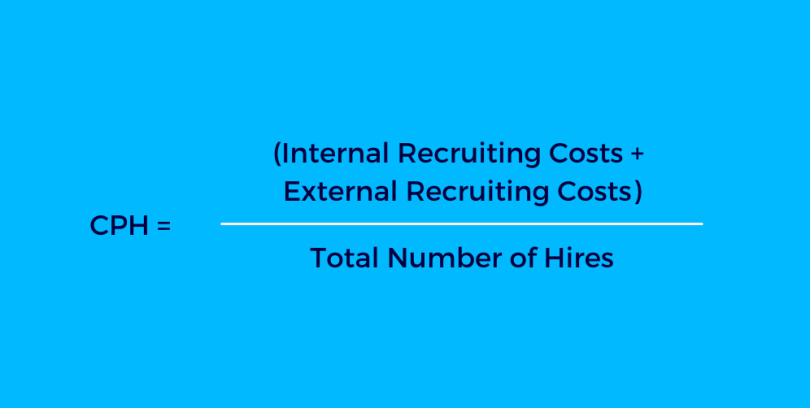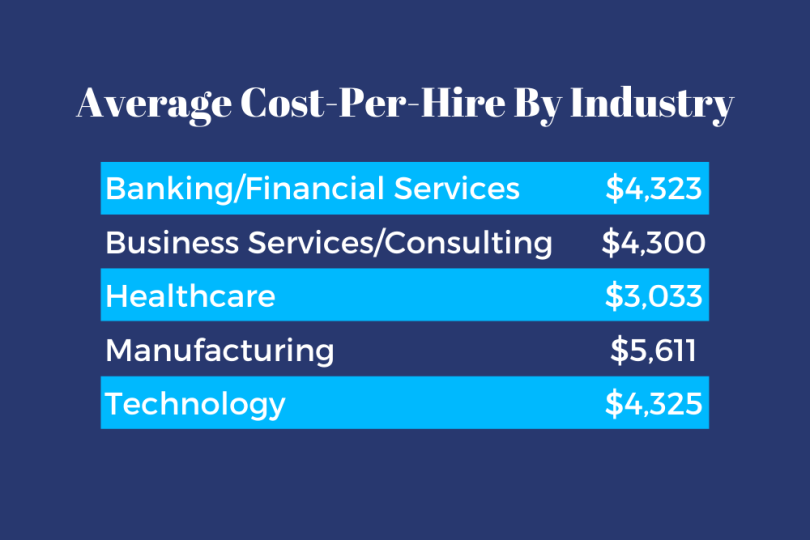Evaluating your recruitment strategies is vital to proving the value of your efforts. Not only that, but understanding the efficiencies and inefficiencies of your recruitment strategies will help you improve metrics. One of the most important metrics, cost-per-hire (CPH) is telling of your team's ability to efficiently recruit candidates, making it critical to understand and regularly keep tabs on.
In this article, we’ll cover the ins and outs of CPH — what it is, why it matters, how to calculate it and how CPH is different from cost-of-vacancy.
How to Determine Cost-Per-Hire
- Understand Why Cost-Per-Hire Is Important
- Consider the Factors That Influence Cost-Per-Hire
- Total Your Internal Recruitment Expenses
- Total Your External Recruitment Expenses
- Calculate Your Cost-Per-Hire
- Compare Cost-Per-Hires By Industry
- Don’t Overlook Hidden Recruitment Costs
What Is Cost-Per-Hire?

Cost-per-hire is the total cost associated with filling an open role. CPH accounts for all financial expenses — including travel costs, agency fees and ad spend — time dedicated to recruitment efforts, net productivity lost while the role is open and the hired candidate’s final salary. CPH does not account for expenses incurred after an individual is hired, such as onboarding and training costs.
Understand Why Cost-Per-Hire Is Important

Determining your cost-per-hire makes it easier to allocate funds for recruiting efforts when finalizing your annual budget. For example, if you plan to hire 20 people in the upcoming year and you’ve calculated your average CPH to be $4,000, you can confidently dedicate $80,000 to your recruiting efforts.
Knowing and continually tracking your organization’s CPH is also useful when evaluating the efficacy of your recruitment strategy. If your cost-per-hire skyrockets next quarter and you hired the same number of employees across similar roles as last quarter, you know to look for discrepancies in your recruiting methods. CPH is a quick check of your team’s success.
While cost-per-hire is an important metric, it does not provide a comprehensive view of your recruiting efforts. Consider time-to-hire and quality of hire when evaluating CPH. If your CPH is higher than the industry average but you’ve quickly acquired elite candidates and retained them over the years, a more expensive CPH is probably worth it. These additional metrics are vital to understand the true cost-per-hire for your organization.
Consider the Factors That Influence Cost-Per-Hire

While you can reliably calculate the cost-per-hire for a given organization, it should be noted that there are several factors that affect CPH. Below are some of the most common and impactful elements to account for when evaluating your cost-per-hire:
Industry
Your cost-per-hire will vary greatly depending on what industry you’re in. For example, the average CPH in healthcare is $3,033, while a new hire typically costs $5,611 in the manufacturing industry.
Staff Size
Large organizations typically have lower cost-per-hires, most likely as a result of their abundance of resources. Conversely, smaller business units don’t make as many hires nor do they always have the budget for an extensive recruitment strategy, which makes their cost-per-hire more expensive. Furthermore, enterprise organizations have more efficient recruitment processes, filling roles as soon as five days before their small to mid-sized counterparts.

Geographic Location
If your company is headquartered in a bustling, major city, you have access to a massive talent pool right outside your door. Conversely, organizations in more remote locations will have to increase recruitment spend to account for additional ad placements, travel expenses for candidate interviews and recruitment bonuses.
Position Type and Level
Intuitively, the cost-per-hire for a C-suite executive is going to be significantly higher than that of an entry level position. The Society for Human Resource Management determined the average cost-per-hire is $4,425, while the average CPH for an executive is more than three times that at $14,936. The interview process for senior level positions will likely be more extensive and require additional staff involvement. Salary and signing bonuses will also be significant factors in a senior level search.
Similarly, the type of position you’re hiring for will affect your CPH. For high-demand roles like engineers, web developers and data scientists, you can expect to dedicate more time to interviewing candidates and more resources to creating competitive offers. For positions that don’t require extensive technical training or additional degrees, your CPH will be lower.
Total Your Internal Recruitment Expenses

In this section, we’ll cover a few of the most common expenses associated with the recruitment process. While this list is not exhaustive and not every factor mentioned will be applicable to your organization, it’s important to consider all costs and consistently calculate cost-per-hire.
Start by looking at industry standards to gauge your own recruitment efforts with those of your competitors. Set a benchmark for yourself to get a better understanding of how your efforts evolve month-over-month and year-over-year.
Make sure to factor the same expenses into your calculation every time. Only new expenses should be added into the equation, like in the instance that you begin to lease additional office space to conduct interviews. However, if you do not account for interview training costs in one calculation, you should not account for it in any subsequent determinations.
First things first, take a look at your team’s direct contribution to your recruitment process by calculating the total cost of the following factors:
Cost of interviews
How much money did you spend on interviews? To calculate this expense, determine the total number of hours each individual spent preparing for, conducting and following up on interviews and multiply that number by the employee's hourly pay rate. Do this for every employee involved in the interview process. Then, add up the individual totals to determine your organization’s total spend on interviews.
Recruiter salaries
Your internal talent team is your greatest recruitment asset and likely your largest expense. Calculate the total cost of this team by totaling annual salaries, benefits and travel expenses for each recruiter.
Referral bonuses
Implementing a referral program can be hugely beneficial to your recruitment efforts. Employee recommendations increase the quality of your applicant pool and help build your talent pipeline. Calculate your total referral spend by tallying up how much you paid employees for candidate recommendations that led to hires over the past 12 months.

Recruitment technology
Automating some of your efforts is a great way to improve the efficiency of your recruitment process. For example, an applicant tracking system (ATS) allows you to track candidates throughout the entire process, automate follow-up communication as well as discern source of application and hire. Additionally, you may use a video conferencing platform like Skype or Zoom to conduct interviews with out-of-state candidates. The service and subscription fees for recruitment tools need to be taken into account when determining your cost-per-hire.
Working environment and resources
It’s not uncommon for organizations to have remote employees, and the added expenses of setting these individuals up with a workspace and tools contributes to your cost-per-hire. Rent for additional space to conduct interviews, the cost of a desk at a communal workspace as well as any necessary infrastructure — a laptop, company cell phone, printer or tablet — and other employee needs are all expenses to include in your calculations.
TOTAL YOUR External Recruiting EXPENSES

Now, let’s take a look at some of the most prominent external recruiting costs. Outside expenses will likely make up a majority of your total spend on recruitment, simply because there are more outside costs. However, that does not negate the value of a dedicated internal talent team. Track the following common external recruiting costs to understand how they impact your cost-per-hire:
Interview training expenses
Equipping your team with the resources and wherewithal to effectively conduct interviews is a necessary recruitment investment. Without proper training, your interviewers and hiring managers are prone to unconscious biases and may unknowingly ask unethical questions that could have legal ramifications. Take note of how much you spend on software or training seminars to educate interviewers.
Employer branding projects
Building your employer brand helps prospective employees get to know you as an employer. This makes it easier for them to accept an offer and greatly reduces your time-to-hire. Factor in the production costs of a company culture video, employee value proposition (EVP) as well as the cost of updating existing collateral materials and public-facing content. Account for time spent on these projects too, by tracking hours and multiplying the total time by the hourly pay rates of the employees involved as well as any external costs, like a video production crew.
Headhunters and outside agencY fees
Are you using a third-party talent agency to source candidates? If so, the added expense is a significant part of your cost-per-hire. Take into consideration how much you’re spending on this outside service — it may behoove you to add additional staff to your talent team and bring the candidate search in-house.

Marketing expenses
To widen your applicant pool, you need to promote your open roles, especially in the digital age. Factor the cost of posting on job boards and all paid ad campaigns you run during a defined time period. Consider leveraging your existing staff by having them post about job opportunities to their personal social media profiles as a low-lift approach to reducing cost-per-hire. Provide employees with guidelines and pre-created content for them to share and bolster your recruitment marketing strategies.
Career fair and industry event expenses
Hosting and attending recruitment events is a great way to match resumes to faces and meet qualified candidates in your markets. While these can be costly endeavors, they’re worthwhile. Consider registration fees, travel and lodging expenses for employees, meal stipends and any production costs for promotional materials you’ll want to have onsite.
Candidate travel expenses
Have a great, out-of-state candidate that you want to bring into the office for an onsite interview? Their travel and lodging expenses contribute to your cost-per-hire. Additionally, you may offer them a stipend for food while they’re in town or take them out for a nice dinner. Factor these expenses into your cost-per-hire calculations.

Relocation expenses
If that out-of-state candidate becomes your newest hire, you may offer them a relocation package or bonus which can vary in expense depending on the level of seniority. This could come in the form of a lump sum they’ll receive after accepting the offer and moving, or you could pay for some of their moving, living accommodations and travel expenses.
Careers page updates and management fees
A recent Randstad Sourceright report indicates that job seekers rely on and trust company websites and careers pages to gather information when on the job hunt. Investing in regular updates to improve user experience — mobile optimization and current design are musts — and maintain your careers page is an important external expense to account for.
Candidate tests and assessments
Are there any tests you conduct prior to finalizing the candidate’s employment with your organization? This could include third-party background checks, drug testing fees, aptitude tests and personality assessments. If so, factor in the cost of these services and any time your team spends analyzing the results in your cost-per-hire calculations.
Calculate Your Cost-Per-Hire
Back in 2012, the American National Standards Institute approved the Society for Human Resource Management’s cost-per-hire standard, which states:

In order for your calculation to be accurate, your total recruiting costs and total number of hires must refer to the same period of time. If you’re calculating CPH for the previous quarter, determine the total cost of recruitment efforts from that time period and divide it by the number of people you hired during the quarter.
Compare Cost-Per-Hires By Industry
According to Bersin by Deloitte’s research, the following totals are the average cost-per-hire based on industry, which are on-par with SHRM’s estimation of $4,425:

Industry benchmarks are helpful metrics to gauge your own recruitment efforts, but your most important data set will be your CPH year-over-year. Track and regularly calculate your cost-per-hire to evaluate your recruitment efforts.
Don’t Overlook Hidden Recruitment Costs

There are certain aspects of the recruitment process that aren’t easily tied to a dollar sign. However, they have a serious impact on your bottom line and cannot be neglected.
Productivity Loss
When hiring managers and team members are conducting interviews, they’re not accomplishing their primary responsibilities. This can lead to delayed projects and missed deadlines, both of which have a noticeable impact on your company’s product output and profitability. While you can calculate the internal cost of interviews, productivity loss is more difficult to measure.
Morale and Company Culture
Your team’s morale and company culture will also take a hit as a result of the vacant position. If team members are particularly close, they’ll notice a coworker’s absence and may resent the organization for their departure.
Additionally, the burden of working two jobs to cover the vacancy can exhaust employees and drain their enthusiasm. An unfilled position increases your employees’ workload and diminishes their engagement levels, a lose-lose situation.
Employee Engagement and Satisfaction
More important, however — and even harder to quantify — is the toll an unfilled role has on your employees. To make up for time lost when writing job descriptions, reviewing resumes and interviewing candidates, hiring managers may be inclined to work after hours. This negatively impacts their work-life balance and happiness at work.
Similarly, if you forego contractors or temporary employees, your team members will have to step up and take on the workload of the vacant role. Working outside of their job description and beyond the office is sure to frustrate employees and can lead to burnout.
The longer a role remains vacant, the longer employees work double-duty. This puts your company at risk for worsening employee engagement which can result in turnover. Another unfilled role results in additional recruiting expenses, can cause further discontent among team members and ultimately jeopardizes your company’s long-term stability and success.
See the pattern here? The most expensive recruiting costs cannot be measured, but are sorely felt throughout the company. Turnover begets turnover, unless your team makes smart investments in your recruitment strategy upfront to reduce time-to-hire and retain your current workforce. To give your recruitment strategy a leg up on the competition, check out these 10 tips to improve the efficiency or your recruitment process.




